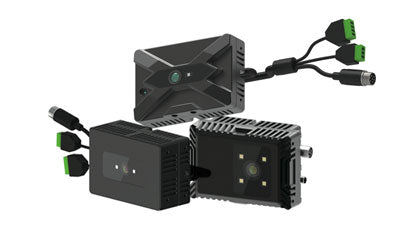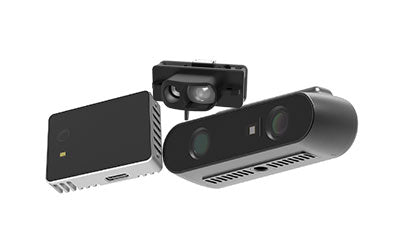TOF Sensors Enhance Autonomous Driving Safety and Intelligent Mobility

With the rapid development of autonomous driving technology, vehicle perception systems have become the core component to ensure the safety of intelligent mobility. Sensor fusion technology is increasingly applied in autonomous driving, and 3D sensing devices based on Time-of-Flight (TOF) technology are gradually becoming a crucial part of the autonomous driving perception framework due to their high accuracy, low latency, and strong anti-interference capability. This article will start from the sensor fusion system, delve into the applications of TOF in in-cabin monitoring and near-field sensing, explore its synergistic advantages with millimeter-wave radar and LiDAR, and provide a forward-looking analysis of the role of TOF technology in future L2 to L5 autonomous driving.
What is a Time-of-Flight Sensor?
A Time-of-Flight (ToF) sensor is a device that measures the time difference between emitting light and receiving its reflection to calculate the distance between the sensor and an object. It typically emits infrared light or laser pulses and uses the speed of light and time intervals to quickly and accurately capture three-dimensional depth information.
In simple terms, a ToF sensor is a “distance meter,” but with high precision and fast speed, making it particularly suitable for high-demand scenarios such as mobile phone face recognition, gesture recognition, autonomous driving, robotic obstacle avoidance, and XR (AR/VR/MR) spatial positioning and environmental sensing.
Its advantages include:
-
Strong real-time capability (millisecond-level distance measurement)
-
High accuracy (effective under complex lighting conditions)
-
Compact module design, easy to integrate
Therefore, ToF sensors are increasingly widely used in modern electronic products, especially in devices requiring precise depth sensing.
Autonomous Driving Sensor Fusion System
The core of autonomous driving systems lies in achieving comprehensive and accurate perception of the vehicle’s surrounding environment, which depends on the collaboration of various advanced sensors. Common sensors include LiDAR, millimeter-wave radar, cameras, and depth cameras based on Time-of-Flight (TOF) technology. Each sensor has its own advantages and limitations, and a single sensor alone cannot meet the diverse environmental perception needs of autonomous driving. Therefore, multi-sensor fusion technology organically combines the strengths of different sensors, forming a complementary system that is key to achieving safe and efficient autonomous driving.
LiDAR, currently the 'eyes' of autonomous driving systems, emits laser beams and receives reflected signals to generate high-precision 3D point cloud data. This point cloud provides precise distances to objects around the vehicle and builds complex 3D environmental models, which are the foundation for environmental perception and path planning in autonomous driving. Especially 3D LiDAR sensors excel in environment modeling and obstacle recognition but tend to be costly and sensitive to adverse weather conditions.
Millimeter-wave radar features longer wavelengths and strong penetration capabilities, maintaining stable detection in rain, fog, snow, and other harsh weather. It is good at detecting fast-moving objects at long distances, filling the blind spots of LiDAR and cameras under extreme weather, ensuring continuous perception and safety warnings for the vehicle.
Traditional cameras provide rich visual information and are excellent at recognizing colors, signs, lane markings, and traffic lights, enhancing the semantic understanding capability of autonomous driving systems. However, cameras are greatly affected by lighting variations and have difficulty accurately obtaining object depth information.
On this basis, TOF sensors, with their high-frame-rate 3D depth imaging capability (3D TOF camera), serve as important supplements for near-field environmental sensing. TOF cameras measure the flight time of light pulses from emission to reflection, precisely calculating object distances and capturing the three-dimensional structure of the environment in real time. Their high accuracy and low latency significantly improve the vehicle’s ability to identify and track nearby dynamic targets, especially suited for driver monitoring systems (DMS), occupant monitoring systems (CMS), and safety protection of vehicle blind spots.
Sensor fusion technology deeply integrates data from LiDAR, millimeter-wave radar, cameras, and TOF sensors at data, decision, and control levels. Using algorithms such as 3D SLAM (Simultaneous Localization and Mapping) and machine learning, the system can generate precise real-time 3D environmental maps, achieving accurate vehicle localization and path planning.
The fusion system not only enhances the accuracy and completeness of environment perception but also significantly improves the overall system’s safety, stability, and anti-interference capability. This is crucial for coping with complex urban traffic, adverse weather, and sudden events, ensuring the stable operation of autonomous vehicles.
Furthermore, with continuous advances in semiconductor technology (semiconductors 2024), the performance and integration level of TOF sensors and related processing chips have greatly improved, while costs have gradually decreased, providing strong support for the widespread adoption and commercialization of sensor fusion systems.
In summary, the sensor fusion system for autonomous driving is achieving full coverage from macro-level environmental perception to micro-level detail capture through the complementary advantages of various advanced sensors and intelligent data integration, laying a solid safety foundation for intelligent mobility.
Applications of TOF in In-Cabin Monitoring (DMS/CMS) and Near-Field Sensing
Based on Time-of-Flight (TOF) sensor technology, autonomous driving systems achieve precise real-time perception of the vehicle interior environment. The core principle of TOF technology is to emit near-infrared light pulses and measure the flight time from emission to reflection back to the sensor, thereby calculating the distance between objects and the sensor to generate high-precision 3D depth images (3D depth camera). This principle endows TOF sensors with fast response, high resolution, and high-accuracy spatial perception capabilities, making them especially suitable for complex in-cabin monitoring and near-field environment sensing scenarios.
In Driver Monitoring Systems (DMS), TOF sensors capture 3D spatial information such as the driver’s head pose, eye gaze direction, and facial expressions to evaluate driver fatigue and distraction in real time. Compared with traditional cameras, TOF cameras’ depth information not only improves recognition accuracy but also effectively avoids misjudgments caused by lighting changes or occlusions, providing more reliable technical support for safe driving.
Combined with AI algorithms and 3D machine vision technologies, the system can intelligently determine whether the driver is in a dangerous driving state and promptly issue warnings, greatly enhancing the active safety of autonomous vehicles.
Passenger Monitoring Systems (CMS) also benefit from TOF technology’s depth sensing advantages. TOF cameras can detect passengers’ posture changes, positions, monitor child safety seat usage, and identify abnormal behaviors (such as passenger falls or left-behind objects) in real time. This information helps autonomous vehicles achieve smarter and more humanized cabin management, enhancing passenger comfort and safety assurance.
Moreover, TOF sensors excel in vehicle near-field sensing applications. Leveraging their high-precision 3D imaging capabilities, TOF cameras can monitor dynamic objects and obstacles within 1–5 meters around the vehicle in real time. For example, when the car door opens, TOF sensors accurately detect passenger positions and external obstacles to prevent pinching accidents, protecting passengers and pedestrians. Their strong resistance to lighting interference also enables stable operation under intense daylight, nighttime low light, or shadowed environments, overcoming the limitations of traditional cameras in complex lighting conditions.
With advancements in semiconductor technology and increased integration of 3D TOF camera chips, TOF sensors now offer advantages of miniaturization and low power consumption, and can seamlessly connect with vehicle intelligent control systems, promoting the widespread adoption of DMS/CMS systems. Coupled with 3D vision systems and machine learning, future autonomous vehicles will achieve smarter, more detailed environment perception inside and outside the cabin, further improving overall vehicle safety and user experience.
In summary, TOF technology, with its precise depth measurement capability and strong environmental adaptability, has become an indispensable key component in autonomous driving perception systems, providing solid technical support for truly safe and intelligent autonomous driving.
Synergistic Complementation with Millimeter-Wave Radar and LiDAR
Millimeter-wave radar and LiDAR each have advantages in autonomous driving. Millimeter-wave radar, due to its longer wavelength, has strong penetration ability and is suitable for detecting distant objects and operating in adverse weather; LiDAR provides high-precision point cloud data to build 3D environmental models.
However, millimeter-wave radar and LiDAR face limitations in near-range object recognition and detail perception. Here, TOF technology’s high-resolution 3D depth cameras (3D TOF cameras) precisely fill this gap, especially excelling in in-cabin monitoring and near-vehicle sensing.
When integrated, the three sensors enable autonomous driving perception systems to achieve seamless coverage from near to far distances, inside and outside the vehicle, significantly improving perception accuracy and response speed.
Discussion on Safety, Stability, and Anti-Interference Capabilities
TOF (Time-of-Flight) sensors, based on light pulse flight time measurement, inherently possess excellent anti-interference capabilities. Compared to traditional 2D cameras, TOF sensors directly obtain 3D distance information of targets and maintain high measurement accuracy in complex environments.
Whether under strong sunlight, weak nighttime light, or complex in-cabin shadows, TOF sensors operate stably, significantly reducing false alarms and missed detections caused by environmental lighting changes. This high real-time and high-precision depth data is critical for ensuring driving safety when autonomous vehicles need to perceive rapidly changing surroundings.
From a system safety perspective, the anti-light interference performance of TOF sensors greatly enhances data reliability. Unlike traditional cameras relying on 2D image analysis, TOF sensors measure light round-trip time unaffected by color or texture, enabling excellent performance in adverse weather conditions (rain, fog, snow) or complex road scenarios. Such stability is crucial for realizing high-level autonomous driving (L2 to L5), ensuring continuous perception capabilities under all conditions and reducing accident risks.
On the technical side, TOF sensor manufacturing relies on advanced semiconductor technology (semiconductors 2024), with ongoing improvements in integration and process technology enabling miniaturization and low power consumption. This reduces overall system energy consumption and facilitates flexible deployment at critical vehicle positions, including in-cabin monitoring (DMS/CMS) and near-field environment sensing. Advanced semiconductor chip manufacturing also drives down production costs, enhancing TOF sensors’ market penetration potential.
Furthermore, modern TOF sensors are equipped with intelligent signal processing algorithms that effectively filter environmental noise and multipath reflection interference, improving data authenticity and stability. This smart data processing allows TOF sensors not only to provide excellent 3D depth perception (3D TOF camera) but also to integrate with other sensors (such as LiDAR and millimeter-wave radar) for a redundant and highly reliable sensor fusion system, strengthening the overall safety of autonomous driving systems.
In conclusion, TOF sensors, with their outstanding anti-interference characteristics, stable operation, and advanced semiconductor technology foundation, have become indispensable core components in autonomous driving perception systems. With continuous innovation in semiconductor and 3D imaging technologies through 2024 and beyond, TOF sensor performance and application scope will keep expanding, driving intelligent mobility toward safer, more stable, and efficient development.
Predicted Role of TOF in Future L2–L5 Level Autonomous Driving
From L2-level driver assistance to fully autonomous L5 driving, perception technology requirements continually escalate. In the future, TOF will not be limited to in-cabin monitoring and near-field sensing but will integrate with 3D SLAM (Simultaneous Localization and Mapping) technology to support real-time 3D environment reconstruction and precise vehicle positioning.
Additionally, TOF sensors’ applications in the 3D machine vision market will expand, becoming key technologies for achieving high-precision autonomous navigation and obstacle avoidance. With the convergence of 3D robotics and intelligent vehicle systems, TOF will assist autonomous vehicles in achieving safer, smarter, and full-scenario perception and decision-making.
Conclusion
In summary, 3D depth sensing devices based on TOF technology, with their unique technical advantages, play an irreplaceable role in the autonomous driving sensor fusion ecosystem. In the future, with deeper integration of TOF 3D sensors with LiDAR and millimeter-wave radar, autonomous vehicles will possess stronger environmental perception capabilities and safety guarantees, injecting new vitality into intelligent mobility.
Synexens Industrial Outdoor 4m TOF Sensor Depth 3D Camera Rangefinder_CS40p
After-sales Support:
Our professional technical team specializing in 3D camera ranging is ready to assist you at any time. Whether you encounter any issues with your TOF camera after purchase or need clarification on TOF technology, feel free to contact us anytime. We are committed to providing high-quality technical after-sales service and user experience, ensuring your peace of mind in both shopping and using our products.
-
Posted in
CS40P





